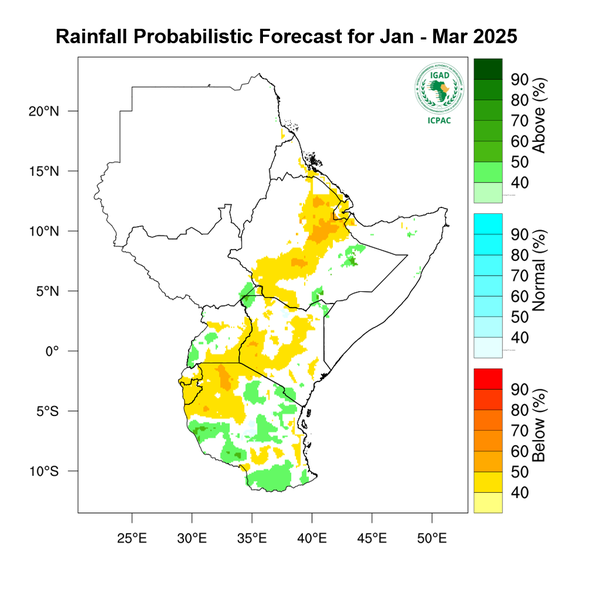SODMA and FAO Call for Immediate Preparedness Measures as Somalia Faces Severe Climate Challenges
Mogadishu, Somalia: Immediate preparedness measures are essential to safeguard Somali communities from the anticipated below-normal rainfall forecast for the March-April-May 2025 (Gu) season. This urgent call was made by the Somalia Disaster Management Agency (SODMA), the Food and Agriculture Organization of the United Nations (FAO), and key representatives from the Federal Government of Somalia (FGS) during the 69th Greater Horn of Africa Climate Outlook Forum (GHACOF 69), held recently in Addis Ababa, Ethiopia.
Noting the critical need for increased investment in anticipatory action, SoDMA Commissioner, Mr. Mohamud Moallim, emphasized, "Since the last rainy season (Deyr 2024) has already failed and the upcoming one (Gu' 2025) is predicted to be below normal, now is the right time to anticipate what might potentially be a full-fledged drought-hazard, which might last for several seasons to come”
The forum's deliberations highlighted the looming climate-driven challenges facing the region. Current forecasts indicate below-normal rainfall, above-normal temperatures, and normal to late onset of the Gu rains for Somalia. These projections, combined with the ongoing hot and dry Jilal season and the poor temporal and spatial distribution of Deyr 2024 rains, signal the potential for severe drought conditions, escalating the already dire/ critical humanitarian needs across the country.
Key Observations:
Deyr 2024 Season Analysis: Most regions in Somalia experienced erratic rainfall patterns. While some areas in Somaliland such as Baki recorded above-normal rainfall, other regions in Galmudug, Hirshabelle, Southwest, Jubaland and Puntland of Somalia faced significantly below-normal rainfall (e.g., Dangaranyo recorded only 7 percent of its long-term mean). This uneven distribution, coupled with prolonged dry spells, had negative impacts on agriculture, water resources, and pastoral livelihoods.
Drought Severity: The combination of the failed Deyr rains and the ongoing hot and dry Jilal season is expected to intensify water shortages, reduce soil moisture, and escalate livestock and crop stress. Projections indicate a high likelihood of drought-induced displacement, food insecurity, and health crises.
Gu 2025 Outlook: The forecast predicts late rains, prolonged dry spells, and increased temperatures, and reflects what was experienced in 2017 and 2021. The dry conditions could significantly undermine agricultural productivity, water availability, and overall resilience.
FAO Representative in Somalia, Etienne Peterschmitt weighed in, observing “The changing climate demands urgent, coordinated action. FAO is committed to supporting Somalia in building resilience through SWALIM and FSNAU programmes, providing evidence-based analysis, early warnings, and data-driven approaches to mitigate drought impacts. Efforts include unconditional cash support, water trucking, and prepositioning of relief packages to save lives and livelihoods while reducing displacement and household vulnerabilities”.
SODMA and FAO Recommendations:
In response to these alarming trends, SODMA and FAO are calling for increased investments in anticipatory action to mitigate the anticipated adverse climate impact on the Gu 2025 season.
A comprehensive approach is required across the various sectors:
For water resources, enhanced management through water harvesting, conservation and enhanced distribution systems is crucial to combat scarcity. Water conservation practices should be promoted at community and household levels. The ongoing monitoring of strategic water points across the country should be expanded, to inform water access drought interventions.
In the agriculture and livelihood sectors, provision of early warning information on the onset and performance of the rains, and advisory on the best suited crop varieties for the below normal rains should be prioritized, alongside access to fodder and livestock treatment programmes to significantly reduce stress on animals and secure food supplies.
The health and wellbeing of the communities needs to be safeguarded through raising of public awareness about heat mitigation measures to combat dehydration and heat-related illnesses and strengthen healthcare systems to address emerging health crises.
On the Humanitarian and Disaster Preparedness pre-positioning of humanitarian supplies and enhancement of early warning systems to support vulnerable populations is recommended. Government led coordinated approaches to intersectoral scale-up readiness, and development of contingency plans for worst-case scenarios, including intensified displacement and food insecurity is critical to combat the situation.
At regional scale collaboration through harmonized climate data reporting frameworks and integrating local and scientific knowledge will enhance decision-making and improve resilience of the vulnerable communities.
SODMA and FAO reiterate the urgent need for immediate and coordinated action among all stakeholders, including international partners, the FGS, and local communities, to address the worsening drought conditions. Humanitarian scale-up readiness as well as investments in resilience-building, early warning systems, and adaptive strategies remain crucial to safeguarding lives and livelihoods.
MORE INFORMATION:
HUNGER SET TO WORSEN IN SOMALIA AS LA NINA DROUGHT LOOMS
SoDMA, FAO, and UNICEF Launch La Niña Preparedness Plan
PRESS CONTACTS:
FAO in Somalia:
Masimba Mathias Nyamanhindi - Communications Specialist
m: +252-770812119 | e: Masimba.Nyamanhindi | @fao.org | X: @faosomalia
SODMA Communications Team
m: +252618805090 | e: communications@sodma.gov.so | X: @SoDMA_Somalia


